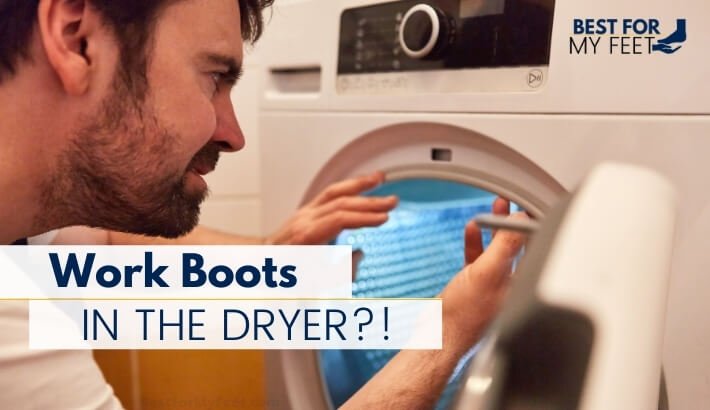When it comes to pretty much every type of footwear out there, work boots included, drying things the good old-fashioned way is the only way to go.

Work boots can handle many scenarios. However, they can NOT take going into the dryer or washing machine.
Putting your work boots through the dryer will decrease the work boot’s lifespan, ultimately ruining them.
But why? Before we explain why, if your work boots are already inside a dryer, take them out ASAP and set them aside.
All set? Alright, let’s get down to it.
What you should consider before putting your work boots in the dryer
The heat from a dryer can arguably be the worst thing you can do to your work boots.
Depending on the material your work boots are made out of, the damage from such extreme heat levels can do anything from aging the work boot’s material rapidly to outright melting off the glue holding the outsoles.
When it comes to cleaning, most work boot manufacturers recommend only using cold water and letting the wind do the drying.
Why?
To give you an idea about how hot a dryer is, the average dryer’s temperature ranges from 125 Fahrenheit/51.2 Celsius to 135 Fahrenheit/57.2 Celsius, which is enough to make most human beings suffer from hypothermia.
Simply put, your work boots won’t stand a chance against such extreme heat unless they’re firefighter work boots, and even then, there’s no guarantee that they’d come out intact.
Can you put steel toe work boots in the dryer?
Short answer, definitely not.
Remember that the upper part of a steel toe work boot is generally made out of leather. Leather shrinks when it’s up against extreme heat or starts to fall apart due to the leather fibers drying from dehydration.
However, there’s an even greater risk to consider: the weight of the boots.
Chances are, the steel in your work boots will damage or dent the steel of the dryer after slamming the inside of the dryer repeatedly as it spins.
Can you put composite toe work boots in the dryer?
Like steel toe work boots, composite toe work boots won’t fare any better in a dryer.
Depending on the material used in the safety toe cap, the heat could outright melt the composite cap (especially if it’s made out of low-quality plastic).
5 Alternatives to dry your work boots fast
We know how important it is to keep your work gear dry, especially after stepping in a pile of muck or getting rid of built-up humidity from wearing your boots after a long and tiring day.
Luckily, there’s a whole bunch of ways to dry them up safely.
Next time your work boots feel a bit damp or are drenched, try these methods:
1. Dry them naturally
It might sound cliché, but keeping your work boots outside in a sunny or well-ventilated place overnight is one of the best ways to get rid of moisture.
Keep your work boots in a diagonal position with the opening facing the sun for the best results. Avoid keeping your work boots under direct sunlight to avoid damaging the leather.
2. Use rice
Rice absorbs moisture well, and if you have a bucket and a lot of rice to spare, you have everything you need to dry up your work boots.
Just fill up a bucket with rice and submerge your work boots to let the rice do its magic.
This method might not work very well if your work boots are soaked, but if they’re just a bit damp, the rice will get the job done in a few hours.
3. Use a fan
If it’s not windy or very sunny to dry your boots, a fan will do the trick. For the best results, tie your work boots with the shoelaces safely to the fan’s cage.
You can even keep your work boots in the sun while placing a fan in front of them to get even faster results.
3. Use a towel
If your work boots are soaked, remove the laces and insoles to dry separately. Then place a towel inside your work boots and wrap them up entirely with another towel.
For faster results, keep your work boots while wrapped up in front of a fan.
4. Use paper towels
For this method, ball up paper towels and place them inside your work boots to absorb the moisture.
This method can work with any paper; however, using newspapers might not be the best option since newspaper ink can stain the insides of your work boots.
5. Use a boot dryer
Boot dryers are electronic devices specifically meant to do what their name implies: to dry up boots.
There are different types of dryers available that use everything from heat to UV light; the good news, though, is unlike using a hairdryer that can roast the material of a work boot, boot dryers are specifically designed to care for boots.
What’s the worst thing that can happen if you dry work boots in a dryer?
If you’re feeling brave and are curious about the worst-case scenarios that can happen to your work boots, expect one or more of the following things to happen when you dry your work boots in a dryer:
- Scenario 1: Your work boots shrink from the heat
- Scenario 2: The outsoles curl up
- Scenario 3: The glue holding the work boots together melts off
- Scenario 4: The leather on your work boots starts to crack and eventually comes apart.
- Scenario 5: Your work boots survive, but their integrity takes a hit, which ultimately risks your foot’s safety
- Scenario 6: Your dryer gets damaged or badly dented
Putting your work boots in the dryer: The takeaway
No matter how tempting it is to throw your work boots into the dryer and hope for the best, we urge you not to unless you intend on testing the limits of your dryer and throwing away your work boots.
Regardless of the setting you put your dryer on, it’s only a matter of time until your work boots hit the dust soon after, or if you’re lucky, they’ll come out worse than they were before you put them in.
The rule of thumb when it comes to drying your boots is never to use an artificial source of heat.
Long story short, to save yourself from the headache of having to get new comfortable work boots, follow a few DIY work boot cleaning methods and stick to the safe options we listed earlier to dry them up.
Learn more about this topic from this sources:
- https://www.livescience.com/34128-limits-human-survival.html
- https://www.keenfootwear.com/faq/?id=205468867&pageTitle=Use%20and%20Care
Team Members Working On This Page

Jessica Flynn – Writer And Researcher
Love technology, going to the beach, take care of my body, and writing (amongst other things). You’ll see my face around here a little bit since I’m responsible for part of the research and writing of some of the articles you’re reading on BestForMyFeet.com. I hope you’ll find our content helpful and enjoyable! See you around, thanks for reading!

Adrian – Editor / Webmaster
Construction Professional, driver, crane operator, cleaner, head chef … these are just some of the jobs I did in the past. Working in all these different environments taught me that having good footwear to protect your feet from different dangers at work IS PARAMOUNT for any worker! On this website, I aim to share all my knowledge and personal experience in dealing with different footwear and foot care issues, and hopefully, you can get something out of it. Enjoy!
source https://bestformyfeet.com/can-you-put-work-boots-in-the-dryer/

 You have 7 days to check out the boots before you send them back!
You have 7 days to check out the boots before you send them back!











